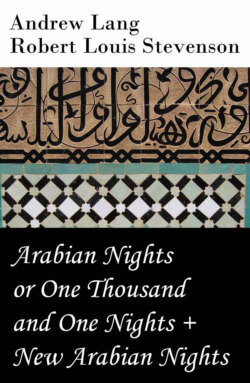Читать книгу Arabian Nights or One Thousand and One Nights (Andrew Lang) + New Arabian Nights (R. L. Stevenson) - Andrew Lang - Страница 4
Preface
ОглавлениеThe stories in the Fairy Books have generally been such as old women in country places tell to their grandchildren. Nobody knows how old they are, or who told them first. The children of Ham, Shem and Japhet may have listened to them in the Ark, on wet days. Hector’s little boy may have heard them in Troy Town, for it is certain that Homer knew them, and that some of them were written down in Egypt about the time of Moses.
People in different countries tell them differently, but they are always the same stories, really, whether among little Zulus, at the Cape, or little Eskimo, near the North Pole. The changes are only in matters of manners and customs; such as wearing clothes or not, meeting lions who talk in the warm countries, or talking bears in the cold countries. There are plenty of kings and queens in the fairy tales, just because long ago there were plenty of kings in the country. A gentleman who would be a squire now was a kind of king in Scotland in very old times, and the same in other places. These old stories, never forgotten, were taken down in writing in different ages, but mostly in this century, in all sorts of languages. These ancient stories are the contents of the Fairy books.
Now “The Arabian Nights,” some of which, but not nearly all, are given in this volume, are only fairy tales of the East. The people of Asia, Arabia, and Persia told them in their own way, not for children, but for grown-up people. There were no novels then, nor any printed books, of course; but there were people whose profession it was to amuse men and women by telling tales. They dressed the fairy stories up, and made the characters good Mahommedans, living in Bagdad or India. The events were often supposed to happen in the reign of the great Caliph, or ruler of the Faithful, Haroun al Raschid, who lived in Bagdad in 786-808 A.D. The vizir who accompanies the Caliph was also a real person of the great family of the Barmecides. He was put to death by the Caliph in a very cruel way, nobody ever knew why. The stories must have been told in their present shape a good long while after the Caliph died, when nobody knew very exactly what had really happened. At last some storyteller thought of writing down the tales, and fixing them into a kind of framework, as if they had all been narrated to a cruel Sultan by his wife. Probably the tales were written down about the time when Edward I. was fighting Robert Bruce. But changes were made in them at different times, and a great deal that is very dull and stupid was put in, and plenty of verses. Neither the verses nor the dull pieces are given in this book.
People in France and England knew almost nothing about “The Arabian Nights” till the reigns of Queen Anne and George I., when they were translated into French by Monsieur Galland. Grown-up people were then very fond of fairy tales, and they thought these Arab stories the best that they had ever read. They were delighted with Ghouls (who lived among the tombs) and Geni, who seemed to be a kind of ogres, and with Princesses who work magic spells, and with Peris, who are Arab fairies. Sindbad had adventures which perhaps came out of the Odyssey of Homer; in fact, all the East had contributed its wonders, and sent them to Europe in one parcel. Young men once made a noise at Monsieur Galland’s windows in the dead of night, and asked him to tell them one of his marvellous tales. Nobody talked of anything but dervishes and vizirs, rocs and peris. The stories were translated from French into all languages, and only Bishop Atterbury complained that the tales were not likely to be true, and had no moral. The bishops was presently banished for being on the side of Prince Charlie’s father, and had leisure to repent of being so solemn.
In this book “The Arabian Nights” are translated from the French version of Monsieur Galland, who dropped out the poetry and a great deal of what the Arabian authors thought funny, though it seems wearisome to us. In this book the stories are shortened here and there, and omissions are made of pieces only suitable for Arabs and old gentlemen. The translations are by the writers of the tales in the Fairy Books, and the pictures are by Mr. Ford.
I can remember reading “The Arabian Nights” when I was six years old, in dirty yellow old volumes of small type with no pictures, and I hope children who read them with Mr. Ford’s pictures will be as happy as I was then in the company of Aladdin and Sindbad the Sailor.
